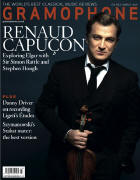Texte paru dans: / Appeared in: |
|
|
Outil de traduction (Très approximatif) |
|
|
Reviewer: Charlotte Gardner Bergamo-born violin virtuoso Pietro Locatelli once described in a 1711 letter how, to improve his violin playing, he used to practise in the choir loft of the city’s Basilica di Santa Maria Maggiore. So it feels rather appropriate that Ilya Gringolts and the Finnish Baroque Orchestra (FiBO) have chosen the spacious acoustic of Järvenpää Church to record Nos 9, 11 and 12 (Il labirinto armonico) from Locatelli’s L’arte del violino set of famously florid violin concertos. What’s more, the whole thing sounds fabulous. First, there’s the sheer energy and joy radiating out from what is a deliciously luminously stringy sound from the orchestra (a nimble ensemble of six violins, two violas, and one each of cello, double bass, harpsichord and lute). Then in comes Gringolts, equally full of stylish, multicoloured élan on his gut-stringed 1770 Gagliano – especially in the outer movements’ solo capriccios; and while you get a generous amount of bloom from the church, the musicians themselves have been captured with just the right degree of not-too-close immediacy for the end result to still sound thoroughly comfortable on the ear. Indeed, beautifully natural. Back to those capriccios, though, because they deserve especial limelight. Genuinely capriccios rather than traditional cadenzas, due to not being thematically linked to the preceding music (No 9 being an exception to that rule), these upper-register confections are replete with all the left-hand virtuosities for which Locatelli was famous – everything from double-stops and unprepared tenths to simultaneously trilling and melodising – and consequently could be regarded as a case of flash triumphing over art. In fact, in 1778 (over a decade after Locatelli’s death), one Benvenuto Robbio, Count of San Raffaele, wrote: ‘He has disfigured his Concertos with the long and most difficult Capriccios, claiming that he wished to adorn them; but they are good only for a thousand shipwrecks.’ So the first thing to admire here is the smoothly organic way in which Gringolts and the FiBO have made them emerge and retreat. Even better, under Gringolts’s fingers they’re swooningly silky, sweettoned, subtly shaded and curved of contour, and this is no small feat – not only did Locatelli himself have a reputation for a less-than-pleasant upper register tone but a quick perusal of the small number of other available recordings of the set will demonstrate quite how difficult it is to pull off the extreme high-register writing of, say, No 11’s opening Allegro without sounding as acidic as a sarcastic lemon. So now that we’ve got a violinist and a band who can bring off these technically fiendish works with such unqualified charm and beauty, and a label presenting them to their best advantage, I’d like to put in an order for the set’s other nine concertos to be recorded forthwith. |
|




